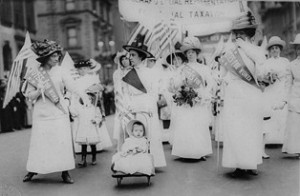joining the franchise: women and the vote

This is probably History 101 for most people but it doesn’t hurt to look at where we’ve come from next to where we are now.
Women in Australia have been able to vote since about the turn of the 20th century, and to stand for election to parliament since the end of the first World War. The first Australian state to grant all women the vote was South Australia in 1894 followed by Western Australia in 1899, NSW in 1902. Victoria bringing up the back of the pack in 1908.
In Tasmania, women became eligible to vote in House of Assembly elections in 1904 following a change to the eligibility criteria from ‘man’ to ‘person’ in the Constitution Act 1903. They were still not eligible to stand for election to either House, and it wasn’t until 1920 that women who had served as nurses in the First World War became eligible to vote in Legislative Council elections.
In 1921 Tasmanian women were granted the right to stand for election, and in 1928 compulsory voting was introduced. It wasn’t until 1968 that full adult franchise was granted for Legislative Council elections. A long drawn out process it seems.
Women were enfranchised nationally through the new Parliament of federated Australia, but did not get to vote until the second Federal election in 1903.
All women, you might ask?
According to the Australian Electoral Commission, Aboriginal Australians already had the vote prior to the referendum. This occurred legally due to the way that the states had drawn up their constitutions. The problem was that hardly anyone knew that this was their right, and in Queensland and Western Australia Aborigines were in fact barred from voting.
There is one story though from Point McLeay, at the Ngarrindjeri mission station near the mouth of the Murray in South Australia where as long ago as the 1890s, Aboriginal men and women voted in South Australian elections and voted for the first Commonwealth Parliament in 1901.
Then in 1902, the Commonwealth passed a “Franchise Act” that set up consistent voting rights across Australia, including a clause banning all “non-whites” from voting, except those who already had State votes. Aboriginal people were included in the definition of “non-whites”.
These new laws should at least have protected the voting rights of Aboriginal people in States where they could vote in State elections, but debate on the interpretation of the Constitution and decisions made by electoral officials resulted in many Aboriginal people losing their right to vote in Federal elections.
In 1967, of course, following a referendum, Aborigines gained full citizenship rights, with which came full voting rights.
The anti-suffragist movement that opposed allowing women the right to vote worldwide argued their case on the basis of supposed female lack of intellect and poor temperament, a focus on the trivial and domestic, emotional, selfish, and that they were bad mothers.
The suffragettes argued that women should have the vote and stand for election in order to be represented in parliament because of course the laws affected women as much as they did men.
It has been 100 years since the initial flashpoints of the suffragettes and we are still remarking as remarkable the election of female Premiers and Prime Ministers, and lamenting the deposition Prime Minister Julia Gillard and her treatment in the media while she was there at the helm.
Australia-wide, there are few women in current positions of Party leadership. In Queensland we have an Opposition Leader Annastacia Palaszczuk, in Tasmania a female Premier – Lara Giddings, and at the Federal level, a Deputy Opposition Leader – Julie Bishop, and of course Leader of the Australian Greens Christine Milne.
This week Christine Milne featured in a tweet that read:
‘Get out of the way Christine and leave it to the big boys’.
Reported on in the Conversation, Senator Milne said,
‘I just thought to myself, that is so symptomatic of the certain element of the Australian population that never accepted women in leadership positions and now feel comfortable that they’ve got their two men back, and they’re happy with that.’
Also this week, Victoria’s only female Premier Joan Kirner has been diagnosed with oesophageal cancer.
Thoughts go out to her family. And they also go to all the other aspiring politicians out there running for office. May the political representatives on 7 September 2013 be elected on their policies and their merits, and may all politicians of the 21st century set a strong example that girls, boys, women and men who hold political leadership as part of their life ambition should all be respected and supported in following that dream.
Do you think Australia still has a problem with women in politics?
Which party best understands and responds to so-called ‘women’s issues’?
Let us know in the comments below!
Got a spare minute? Why not fill out the Lip reader survey, for your chance to win a free copy of issue 23 + an awesome Lip tote bag? We’d love to hear your thoughts!

